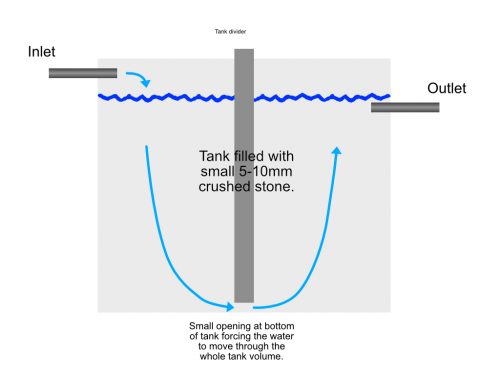Mechanical filtration of nutrient solution in NFT hydroponic systems
Mechanical filtration is not an effective tool to prevent water borne diseases in NFT hydroponic nutrient solutions. It has been found that the total organic carbon content can reach 20 mg.L-1 for 2-3 months without affecting plant growth. There are many other compounds that attribute to the total carbon mass such as chelates and the biomass of microbes. By replenishing all the circulating water on a continuous basis, most of the organic material will be removed in any case. Extensive work has been done on biological filters which show positive results in preventing pythium. However, once the disease reaches the root system there is not much one can do to reduce its effect other than remove all the plants, clean the system and re-plant. It is possible to run a closed hydroponic system for 90 days without filtration and without replacing all the water. The disadvantage of this method is the build-up of certain nutrients in the water causing an imbalance of nutrients (See the post on refilling nutrient solutions and differential uptake of nutrients.
It has been found that after a while, an equilibrium exists between micro-organisms on root surfaces and root exudates. The micro-organisms degrade additional organic material to CO2. It is a well known fact that plants which are under stress release more exudates, however, since plants which grow under hydroponic conditions are under less stress, the concentration of exudates will be less.
The only time when mechanical filtration is required, is when the water source is polluted or has some soil or other inorganic matter. Depending on the amount of inorganic material, the roots of the plants will be suspended in a dense powder at the bottom of the gullies. This suspension has little oxygen for the roots to grow in and will affect plant growth and root development.
Slow filtration is more effective than than fast filtration1)Wohanka, Walter & Luedtke, H. & Ahlers, H. & Luebke, M.. (1999). Optimization of slow filtration as a means for disinfecting nutrient solutions. Acta Hort.. 481. 539-544 . Bacteria have time to remove the organic compounds in the water, resulting in cleaner water.
Another way to use slow sand filtration. A large tank with two sections are used. The sections are connected with a horizontal slit at the bottom of the tank. This forces the water to flow downward and then up to the outlet. The tanks are filled with cleaned gravel which increases the surface area for bacteria and algae which feed on nutrients and other bacteria. This is probably one of the best passive methods to clean nutrient water 2)Wohanka, Walter. (1995). Disinfection of recirculating nutrient solutions by slow sand filtration. Acta Hort.. 382. 246-255. 10.17660/ActaHortic.1995.382.28..

References
| ↑1 | Wohanka, Walter & Luedtke, H. & Ahlers, H. & Luebke, M.. (1999). Optimization of slow filtration as a means for disinfecting nutrient solutions. Acta Hort.. 481. 539-544 |
|---|---|
| ↑2 | Wohanka, Walter. (1995). Disinfection of recirculating nutrient solutions by slow sand filtration. Acta Hort.. 382. 246-255. 10.17660/ActaHortic.1995.382.28. |



